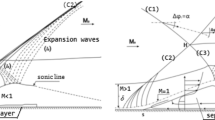Abstract
In order to develop a wall function boundary condition for high-speed flows so as to reduce the grid-dependence of the simulation for the skin friction and heat flux, a research was performed to improve the compressible wall function boundary condition proposed by Nichols. Values of parameters in the velocity law-of-the-wall were revised according to numerical experiments and the expression of temperature law-of-the-wall was modified based on theoretical analysis and numerical simulation. Besides, the formula of the heat conduction term in near-wall region was derived so that the coupling between the wall function boundary condition and CFD code was realized more accurately. Whereafter, the application study of the modified wall function was carried out. The numerical case of supersonic turbulent boundary layer on a flat plate illustrated that the modified wall function produces reasonable results of skin friction and heat flux, and profiles of velocity, temperature and turbulent eddy viscosity for coarse grids with the initial wall spacing of y +<400, and that the modifications to the original wall function can obviously improve the simulation precision. As for the application of separation flows, it was found from the numerical cases of supersonic cavity flow and hypersonic axisymmetric compression corner that the compressible velocity law-of-the-wall originally established based on the fully-developed attached turbulent boundary layer approximately holds in the near-wall region inside the separation flows, which ensures that reliable skin friction and heat flux can be given by the wall function inside the separation flows, while for the region near separation and reattachment points, the wall function gives results with a relatively large error, because the velocity law-of-the-wall used in the wall function takes on obvious deviation from the real velocity profiles near the separation and reattachment points.
Similar content being viewed by others
References
Thivet F, Besbes O, Knight D D. Effect of grid resolution on accuracy of skin friction and heat transfer in turbulent boundary layers. AIAA 2000-0820
Stephen J A. A structured-grid quality measure for simulated hyper-sonic flows. AIAA 2004-0612
Nichols R H, Nelson C C. Wall function boundary conditions including heat transfer and compressibility. AIAA J, 2004, 42: 1107–1114
Wilcox D C. Turbulence Modeling for CFD. 2nd ed. California: DCW Industries, 2000
Douglas L S. Application of wall functions to generalized nonorthogonal curvilinear coordinate systems. AIAA J, 1995, 33: 33–41
Vance D. Investigation of wall function and turbulence model performance within the WIND code. AIAA 2005-1002
Fico V, Cutrone L, Battista F. Assessment of wall-functions k-ɛ turbulence models for the prediction of the wall heat flux in rocket combustion chambers. AIAA 2008-4558
White F M, Christoph G H. A simple theory for the two-dimentional compressible turbulent boundary layer. J Basic Energ, 94: 636–642
Lee J D, Stephen M R. Development of a turbulent wall-function based viscous cartesian-grid methodology. AIAA 2007-1326
He X Z, Zhao H Y, Le J L. Application of wall function boundary condition considering heat transfer and compressibility. Acta Aerodyn Sin, 2006, 4: 450–453
Spalding D B. A single formula for the law of the wall. J. Appl Mech, 1961, 28: 444–458
Chen M Z. Fundamentals of Viscous Fluid Dynamics. Beijing: High Education Press, 2002
White F M. Viscous Fluid Flow. 2nd ed. New York: McGraw-Hill Inc., 1991
Gao Z X, Lee C H. Flamelet model for turbulent diffusion combustion in supersonic flow. Sci China Tech Sci, 2010, 53: 3379–3388
Gao Z X, Lee C H. A numerical study of turbulent combustion characteristics in a combustion chamber of a scramjet engine. Sci China Tech Sci, 2010, 53: 2111–2121
Roe P L. Approximate Riemann solvers, parameter vectors and difference schemes. J Comput Phys, 1981, 43: 357–372
Menter F R. Two-equation eddy-viscosity turbulence models for engineering applications. AIAA J, 1994, 32: 1598–1605
Duan L, Beekman I, Martin M P. Direct numerical simulation of hypersonic turbulent boundary layers. Part 2: Effect of wall temperature. J Fluid Mech, 2010, 655: 419–445
Duan L, Martin M P. Direct numerical simulation of hypersonic turbulent boundary layers. Part 4: Effect of high enthalpy. J Fluid Mech, 2011, 684: 25–59
Tennekes H, Lumley J L. A First Course in Turbulence. Cambridge MA: MIT Press, 1974
Horstman C C, Settles G S, Williams D R. et al. A reattaching free shear layer in compressible turbulent flow. AIAA J, 1982, 20: 79–85
Paciorri R, Dieudonne W, Degrez, et al. Validation of the Spalart-Allmars turbulence model for application in hypersonic flows. AIAA 97-2023
Author information
Authors and Affiliations
Corresponding author
Rights and permissions
About this article
Cite this article
Gao, Z., Jiang, C. & Lee, C. Improvement and application of wall function boundary condition for high-speed compressible flows. Sci. China Technol. Sci. 56, 2501–2515 (2013). https://doi.org/10.1007/s11431-013-5349-4
Received:
Accepted:
Published:
Issue Date:
DOI: https://doi.org/10.1007/s11431-013-5349-4




